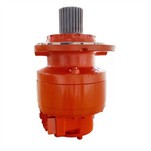1. The amount of leakage is unstable. Its leakage is not the same at every moment, and it fluctuates periodically with the change of phase angle of the rotor. Because the flow rate entering the motor at low speed is relatively small, the proportion of leakage is relatively large, and the instability of the leakage amount will obviously interfere with the flow value of the motor work, so that the speed of the motor is unstable.
2. The size of friction is unstable. Ordinary friction increases with speed, but the frictional resistance inside the motor operating in the stationary and low-speed area is not this law, and when the working speed increases slightly, the frictional resistance not only does not increase, but decreases. On the other hand, the hydraulic motor and load are pushed by the pressure rise after the hydraulic oil is compressed.
3. The motor speed is too low. When the motor speed is too low, due to the gap between the machinery, it is inevitable to produce leakage, and the amount of leakage in each plunger post is different, which will lead to discordant sliding between the speed of the motor and the crankshaft, macroscopically, it is the crawling phenomenon of the motor.






